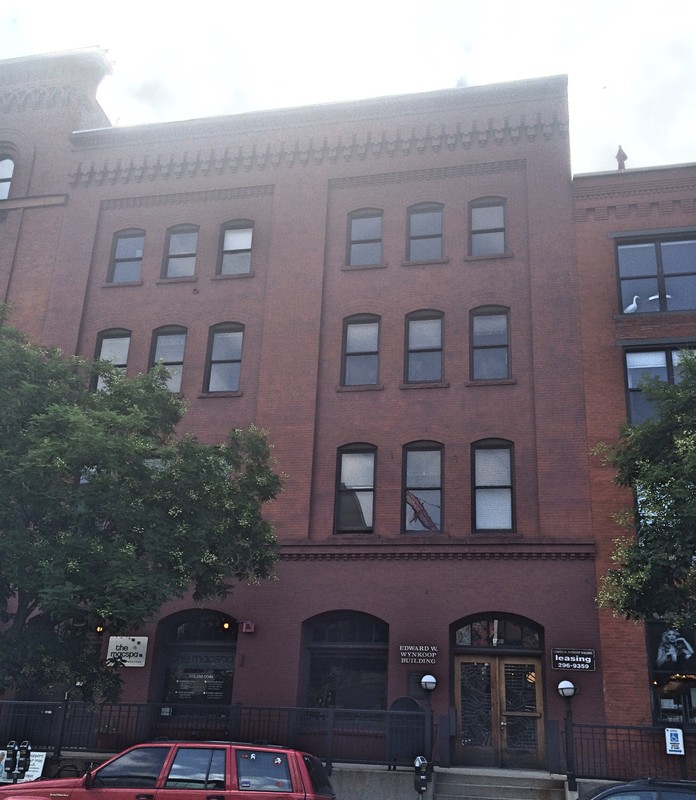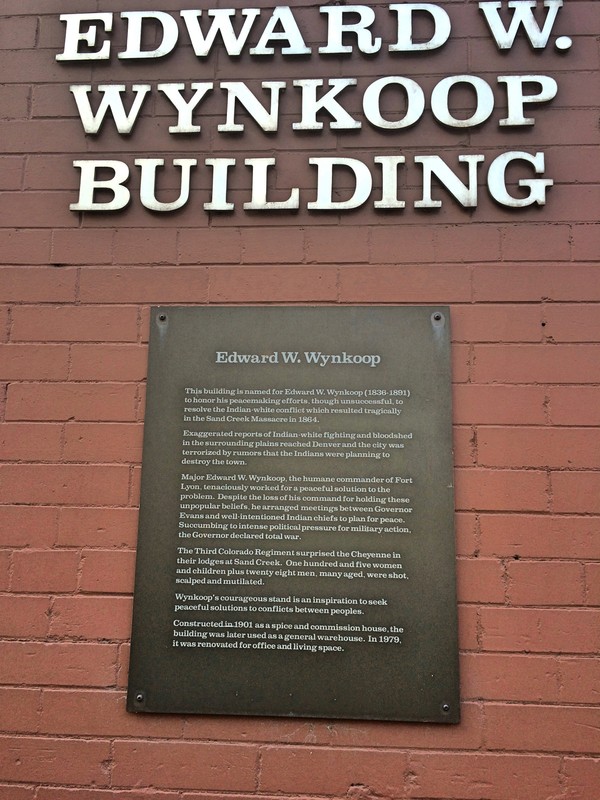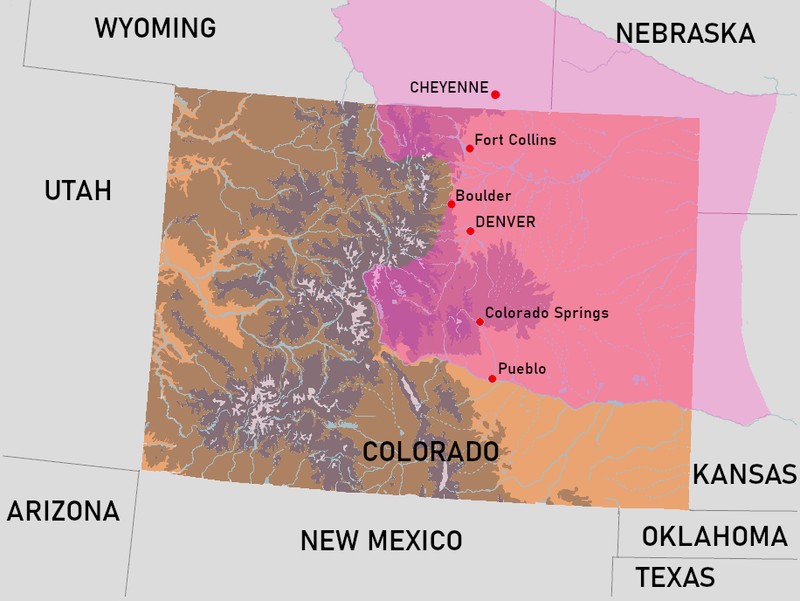Edward W. Wynkoop Building
Introduction
Text-to-speech Audio
This building was completed in 1901 and named after U.S. Army officer, Indian agent, and one of Denver's founders, Edward K. Wynkoop (1836-1891). In 1864, Wynkoop served as the commander of Fort Lyon located to the southeast corner of Colorado in what is now Bent County. Wynkoop was known for being a strong advocate for the Cheyenne and Arapaho Indians in their struggle for some measure of autonomy against encroaching settlers on tribal lands, but his advocacy did not prevent a pair of deadly massacres and he later resigned in protest of the actions by other military leaders. The building was dedicated in Wynkoop's memory and is now an office and apartment building.
Images
The Edward W. Wynkoop Building was erected in 1901.


Edward K. Wynkoop (1836-1891)

The Cheyenne and Arapaho lands after the Treaty of Fort Laramie.

The Cheyenne and Arapaho lands after the Treaty of Fort Lyon.

Backstory and Context
Text-to-speech Audio
Edward W. Wynkoop was born on June 19, 1836 in Philadelphia. The youngest of eight children, he was the grandson of John Henry Wynkoop (1789-1791), who served in the Continental Congress and in the U.S. House of Representatives. In 1856, Wynkoop moved to the capital of the Kansas Territory where he got a job as clerk for his brother-in-law who worked for the United States Land Office. He also became involved with Democratic party politics and befriended territorial Governor James Denver. In 1858, Denver appointed Wynkoop as sheriff of Arapaho County, which comprised the northeastern quarter of what is now Colorado. Three years later he met and married his wife Louise who was a singer and actress.
Wynkoop arrived in the Kansas Territory in the midst of rising tension between settlers and Indians. In 1851, the federal government and seven tribes, including the Cheyenne and Arapaho, signed the Treaty of Fort Laramie. For the Cheyenne and Arapaho, the treaty established a reserve for them south of the North Platte River. This area included parts of present-day southeast Wyoming, southwest Nebraska, western Kansas, and much of eastern Colorado. However, miners and settlers began to arrive in Colorado after gold was discovered in the Rocky Mountains in 1858. Pressure mounted on the government to reduce the size of the Cheyenne and Arapaho's lands. In the 1861 Treaty of Fort Wise, a small number of Cheyenne and Arapaho chiefs ceded the majority of tribal territory to the government, leaving them only 4 million acres of what had been more than 44 million acres (many of the chiefs later said they did not understand the treaty terms and did not want to cede the 1851 lands). In return the government agreed to protect the tribes and provide them with supplies.
However, most of the Cheyenne and Arapaho rejected the treaty and refused to move to the reservation. Tension and violent confrontations continued to rise after the treaty was signed and war broke out in 1864. A group of chiefs, which included one named Black Kettle, sent Wynkoop a letter stating their desire for peace. They met and the chiefs were impressed with Wynkoop. Black Kettle said “This white man is not here to laugh at us…but…unlike the rest of his race, he comes with confidence in the pledges given by the red man.” Wynkoop arranged a meeting between the chiefs Governor Evans in Denver. The chiefs agreed to relocate to the reservation in exchange for protection of the U.S. Army. Around 750 Cheyenne and Arapaho Indians arrived in October and camped next to Big Sandy Creek, which is around 40 miles from Fort Lyon. They flew an American flag and a white flag to signal their intention to be peaceful. Wynkoop was transferred to Fort Riley in Kansas on November 26.
Three days later, Colonel John M. Chivington of the U.S. Volunteers led an attack on the camp with 700 troops. Soldiers not only killed more than one hundred people but mutilated bodies and took scalps and other body parts as trophies. Upon learning of the massacre, Wynkoop was outraged. He was ordered to conduct an investigation and returned to Fort Lyon in January. He found that human remains were still at the massacre site and, in his report, called Chivington an "inhumane monster." The military and Congress also conducted investigations of the massacre but Chivington was never held accountable.
In 1866, Wynkoop was appointed as an Indian agent to the Cheyenne and Arapaho. He resigned two years later after the U.S. Army attacked Black Kettle's village on the Washita River in Oklahoma, concluding that he could no longer protect the tribes. In the coming years, Wynkoop operated an iron foundry with a brother in Philadelphia, joined the gold rush in the Black Hills in South Dakota, served a timber agent for the U.S. Land Office in Denver and in Santa Fe, New Mexico, invested in mining, and was heavily involved in veterans' organizations. In 1885, he became warden of the New Mexico Penitentiary. He died on September 11, 1891.
Sources
"Edward W. Wynkoop." The Historical Marker Database. Accessed August 22, 2023. https://www.hmdb.org/m.asp?m=97294.
"Edward Wynkoop." National Park Service. Last Updated August 4, 2020. Accessed August 22, 2023. https://www.nps.gov/people/edward-wynkoop.htm.
Isern, Dr. Thomas. "The Controversial Career of Edward W. Wynkoop." The Colorado Magazine, 56 (Winter-Spring 1979): pp. 1-18. Retrieved from Roots Web on August 22, 2023. https://freepages.rootsweb.com/~wynkoop/genealogy/webdocs/isern.htm.
Sainio, Eric. "Between Fort Laramie and Fort Wise – A Tale of Two Treaties." National Park Service. January 22, 2014. https://www.nps.gov/sand/learn/news/a-tale-of-two-treaties.htm.
Troyer, Michael D. "Treaty of Fort Wise." Colorado Encyclopedia. Last Modified November 26, 2022. Accessed August 22, 2023. https://coloradoencyclopedia.org/article/treaty-fort-wise.
The Historical Marker Database
Wikimedia Commons: https://commons.wikimedia.org/wiki/File:Arapahoe_Cheyenne_Land_1851.jpg
National Park Service
